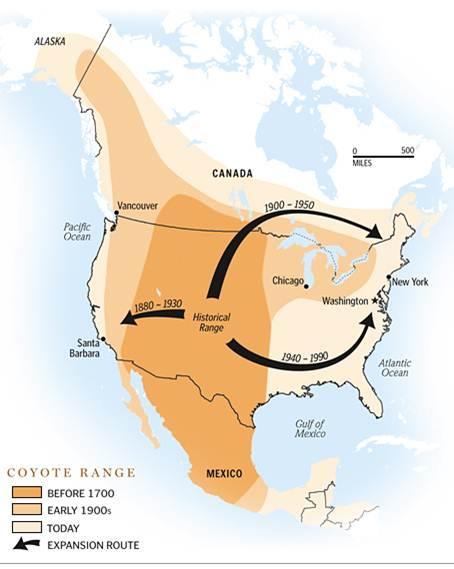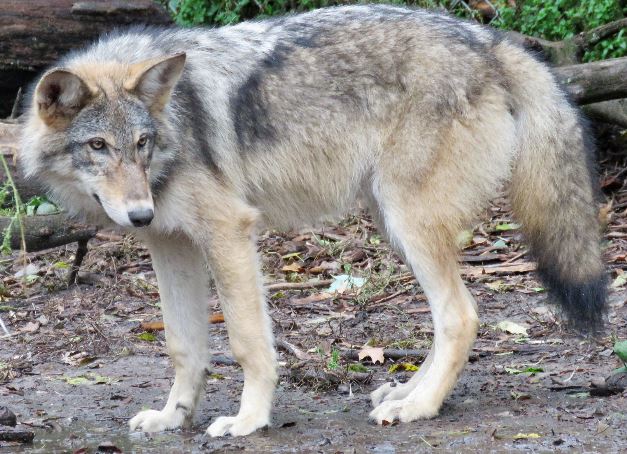Post by PaulsLaugh on Oct 25, 2023 12:39:06 GMT

Florida author and humorist Craig Pittman posted an observation to Facebook that could surprise some suburb dwellers who figured coyotes were a part of the American Southwest and the hapless foil in old “Road Runner” Looney Tunes cartoons.
“A few days back, around dusk, my wife and I turned our car into our neighborhood headed for home and spotted what appeared to be a coyote,” Pittman wrote from his St. Petersburg neighborhood. “We circled the block and came back for another look and sure enough, that’s what it was. The next day, again at dusk, we saw the coyote again, but we haven’t spotted it since. I am assuming he got hit by an Acme anvil while chasing a road runner.”
Readers of a certain age who remember Saturday morning cartoons will chuckle at the punchline that references the hapless Wile E. Coyote and his fruitless battles with the wilier “beep-beep” road runner character. The coyote’s misadventures usually ended with an anvil falling off a mountain and pounding the animal’s head into the unforgiving desert floor.
Coyotes in South Florida suburbs
But Pittman, an environmental writer and contributor to the nonprofit news site Florida Phoenix, is not alone. A scan of neighborhood social media sites like NextDoor and Facebook reveals coyotes are not the stuff of the American Southwest or cartoons.
Coyotes have hit the suburbs.
“Much maligned, little understood. The coyote is now part of the Florida ecosystem and has probably always been here,” Charles Lee, of Audubon Florida, posted in response to Pittman’s post.
“They’ve been seen in Miami-Dade County for a number of years,” Miami’s Mary Sheehan Larrick mentioned in the same thread.
A NextDoor user in Plantation captured an image of a coyote near a lake house in the Nob Hill residential community in Broward County earlier in October.
“They roamed through [the] neighborhood and [were] seen back at same lake at 7 a.m. Please be careful with small pets and children — one of them was resting under a truck in someone’s driveway,” the post warned.
Coyotes discovered Florida
Coyotes, in the same family as dogs, wolves and foxes, began expanding their range into northwestern Florida in the 1960s and are now considered to be a naturalized species in all 67 Florida counties, the Florida Fish and Wildlife Conservation Commission said in an email to the Miami Herald.
“Coyotes prefer to feed in open space. The conversion of forest to agricultural lands has provided coyotes with ample habitat in which to find food and connected habitat throughout the state. Also, red wolves are no longer present, so coyotes have less competition,” according to the FWC.
“Coyotes have actually been in South Florida for years,” Ron Magill, Zoo Miami’s communications director, said in an interview with the Miami Herald. “As their numbers have grown, they have been seen more often and therefore, the reports of those sightings have also increased.
“Coyotes are some of the most adaptable animals in the country and can be found from the rural areas of the west to major cities like Chicago,” he said. “There really is no time of year when they are more prevalent here in Miami but will avoid being active during the heat of the day, finding shelter wherever there is shade and isolation. They are primarily active in the evening and early morning hours.”
Coyotes’ prey
— Description:Salt and pepper gray or brown, with bushy tails and weighing 20 to 35 pounds, “generally speaking, they are very shy animals and will avoid human contact whenever possible,” Zoo Miami’s Magill said. “That is part of the reason why they were not often seen when they first arrived in Miami and the surrounding areas. They migrated to South Florida naturally and were not ‘introduced’ through any human actions.”
— On the menu:Coyotes are also “opportunistic omnivores,” meaning that they eat whatever animal and plant material is most abundant, according the Florida Fish and Wildlife Conservation Commission.
— Concerns: “I don’t think Wile E. is going to run into many Road Runners in Florida, but he sure is making Sylvester and his friends nervous! Suffering Succotash!!” Sandra Rinaldi quipped on Pittman’s post — but she raises a concern many neighbors have in Florida’s suburbs.
— Impact on pets: Smaller pets, like cats, smaller breeds of dogs, and birds could fall victim to a hungry coyote. So could small mammals and they will be attracted to pet food left outdoors and food waste in the trash, Magill said.
— Human risk:Generally speaking, coyotes don’t pose a threat to adult humans, though there have been rare attacks on smaller people or kids.
What should you do if you see a coyote?
— Take a stance:“If someone sees a coyote, the worst thing you can do is turn and run away from it!” Magill said in an email. “What you need to do, much like if you see a Florida black bear, is raise your arms up to make yourself look as large as possible while firmly yelling at the coyote. Do not turn your back and do not charge the animal. Simply make yourself look as large as possible and yell firmly at it, never taking your eyes off it until it hopefully runs off which is what will happen 99% of the time.”
And for that remaining 1%?
— Inform the authorities: “We would like to know about any wildlife that are behaving strangely or aggressively and can be reached at your regional FWC office,” the Florida Fish and Wildlife Conservation Commission said. Find your Florida region at myfwc.com/contact/fwc-office/regional-offices/. “Because coyotes are found in all 67 Florida counties, just seeing one is not a cause for concern. There is no need for members of the public to report dead coyotes, or coyote sightings,” according to the FWC.
Steps to protect your pets
The FWC suggests these tips for minimizing interactions with coyotes.
— People can help prevent interactions between coyotes, along with other wildlife, and pets by keeping cats inside and walking dogs on a short leash, especially when walking dogs in wooded areas or heavy foliage.
— Secure trash, feed pets inside, clean grills, and pick up any fallen fruit or bird seed from the yard. Never feed coyotes or other wildlife.
— Close off any crawl spaces under porches and sheds to prevent coyotes and other wildlife from resting or making these spaces dens.
— If pets are kept in a fenced area, the fence should be high enough — about six feet — to deter coyotes and other wildlife from jumping over and check the bottom of the fence regularly to make sure that coyotes cannot crawl underneath.
More advice from an expert
— Less risk than dogs: “I wouldn’t consider coyotes to be a problem unless I leave my pets outdoors where they could be preyed upon or my garbage uncovered. Of course, they may also become a vector for the spread of disease such as rabies, distemper and mange. However, not anymore so than stray dogs,” the zoo’s Magill said. “In fact, I consider stray dogs to pose a bigger danger because they have been domesticated and have often lost their natural fear of humans and are not as quick to avoid humans as coyotes would be which could make them more aggressive.
— Rodent control: “The bottom line is that instead of fearing coyotes, we should learn to coexist with them and should be able to do so without much effort,” Magill said. “They are quite effective in controlling vermin such as rodents which really pose much greater threats, both health and economics. I have seen several coyotes around West Kendall and the zoo over the last couple of years and have not seen any issues as a result of their presence.”
nordot.app/1089845650847121559?c=592622757532812385
“A few days back, around dusk, my wife and I turned our car into our neighborhood headed for home and spotted what appeared to be a coyote,” Pittman wrote from his St. Petersburg neighborhood. “We circled the block and came back for another look and sure enough, that’s what it was. The next day, again at dusk, we saw the coyote again, but we haven’t spotted it since. I am assuming he got hit by an Acme anvil while chasing a road runner.”
Readers of a certain age who remember Saturday morning cartoons will chuckle at the punchline that references the hapless Wile E. Coyote and his fruitless battles with the wilier “beep-beep” road runner character. The coyote’s misadventures usually ended with an anvil falling off a mountain and pounding the animal’s head into the unforgiving desert floor.
Coyotes in South Florida suburbs
But Pittman, an environmental writer and contributor to the nonprofit news site Florida Phoenix, is not alone. A scan of neighborhood social media sites like NextDoor and Facebook reveals coyotes are not the stuff of the American Southwest or cartoons.
Coyotes have hit the suburbs.
“Much maligned, little understood. The coyote is now part of the Florida ecosystem and has probably always been here,” Charles Lee, of Audubon Florida, posted in response to Pittman’s post.
“They’ve been seen in Miami-Dade County for a number of years,” Miami’s Mary Sheehan Larrick mentioned in the same thread.
A NextDoor user in Plantation captured an image of a coyote near a lake house in the Nob Hill residential community in Broward County earlier in October.
“They roamed through [the] neighborhood and [were] seen back at same lake at 7 a.m. Please be careful with small pets and children — one of them was resting under a truck in someone’s driveway,” the post warned.
Coyotes discovered Florida
Coyotes, in the same family as dogs, wolves and foxes, began expanding their range into northwestern Florida in the 1960s and are now considered to be a naturalized species in all 67 Florida counties, the Florida Fish and Wildlife Conservation Commission said in an email to the Miami Herald.
“Coyotes prefer to feed in open space. The conversion of forest to agricultural lands has provided coyotes with ample habitat in which to find food and connected habitat throughout the state. Also, red wolves are no longer present, so coyotes have less competition,” according to the FWC.
“Coyotes have actually been in South Florida for years,” Ron Magill, Zoo Miami’s communications director, said in an interview with the Miami Herald. “As their numbers have grown, they have been seen more often and therefore, the reports of those sightings have also increased.
“Coyotes are some of the most adaptable animals in the country and can be found from the rural areas of the west to major cities like Chicago,” he said. “There really is no time of year when they are more prevalent here in Miami but will avoid being active during the heat of the day, finding shelter wherever there is shade and isolation. They are primarily active in the evening and early morning hours.”
Coyotes’ prey
— Description:Salt and pepper gray or brown, with bushy tails and weighing 20 to 35 pounds, “generally speaking, they are very shy animals and will avoid human contact whenever possible,” Zoo Miami’s Magill said. “That is part of the reason why they were not often seen when they first arrived in Miami and the surrounding areas. They migrated to South Florida naturally and were not ‘introduced’ through any human actions.”
— On the menu:Coyotes are also “opportunistic omnivores,” meaning that they eat whatever animal and plant material is most abundant, according the Florida Fish and Wildlife Conservation Commission.
— Concerns: “I don’t think Wile E. is going to run into many Road Runners in Florida, but he sure is making Sylvester and his friends nervous! Suffering Succotash!!” Sandra Rinaldi quipped on Pittman’s post — but she raises a concern many neighbors have in Florida’s suburbs.
— Impact on pets: Smaller pets, like cats, smaller breeds of dogs, and birds could fall victim to a hungry coyote. So could small mammals and they will be attracted to pet food left outdoors and food waste in the trash, Magill said.
— Human risk:Generally speaking, coyotes don’t pose a threat to adult humans, though there have been rare attacks on smaller people or kids.
What should you do if you see a coyote?
— Take a stance:“If someone sees a coyote, the worst thing you can do is turn and run away from it!” Magill said in an email. “What you need to do, much like if you see a Florida black bear, is raise your arms up to make yourself look as large as possible while firmly yelling at the coyote. Do not turn your back and do not charge the animal. Simply make yourself look as large as possible and yell firmly at it, never taking your eyes off it until it hopefully runs off which is what will happen 99% of the time.”
And for that remaining 1%?
— Inform the authorities: “We would like to know about any wildlife that are behaving strangely or aggressively and can be reached at your regional FWC office,” the Florida Fish and Wildlife Conservation Commission said. Find your Florida region at myfwc.com/contact/fwc-office/regional-offices/. “Because coyotes are found in all 67 Florida counties, just seeing one is not a cause for concern. There is no need for members of the public to report dead coyotes, or coyote sightings,” according to the FWC.
Steps to protect your pets
The FWC suggests these tips for minimizing interactions with coyotes.
— People can help prevent interactions between coyotes, along with other wildlife, and pets by keeping cats inside and walking dogs on a short leash, especially when walking dogs in wooded areas or heavy foliage.
— Secure trash, feed pets inside, clean grills, and pick up any fallen fruit or bird seed from the yard. Never feed coyotes or other wildlife.
— Close off any crawl spaces under porches and sheds to prevent coyotes and other wildlife from resting or making these spaces dens.
— If pets are kept in a fenced area, the fence should be high enough — about six feet — to deter coyotes and other wildlife from jumping over and check the bottom of the fence regularly to make sure that coyotes cannot crawl underneath.
More advice from an expert
— Less risk than dogs: “I wouldn’t consider coyotes to be a problem unless I leave my pets outdoors where they could be preyed upon or my garbage uncovered. Of course, they may also become a vector for the spread of disease such as rabies, distemper and mange. However, not anymore so than stray dogs,” the zoo’s Magill said. “In fact, I consider stray dogs to pose a bigger danger because they have been domesticated and have often lost their natural fear of humans and are not as quick to avoid humans as coyotes would be which could make them more aggressive.
— Rodent control: “The bottom line is that instead of fearing coyotes, we should learn to coexist with them and should be able to do so without much effort,” Magill said. “They are quite effective in controlling vermin such as rodents which really pose much greater threats, both health and economics. I have seen several coyotes around West Kendall and the zoo over the last couple of years and have not seen any issues as a result of their presence.”
nordot.app/1089845650847121559?c=592622757532812385




![[shrug]](http://storage.proboards.com/6870873/images/GNdzQKpfkkHBBwUPdCiE.gif)




![[grin]](http://storage.proboards.com/6870873/images/CBubFSUbXfyoLMZUjeBb.gif)



![[cheers]](http://storage.proboards.com/6870873/images/aglhVEHQrHaJeFlTZSWP.gif)
